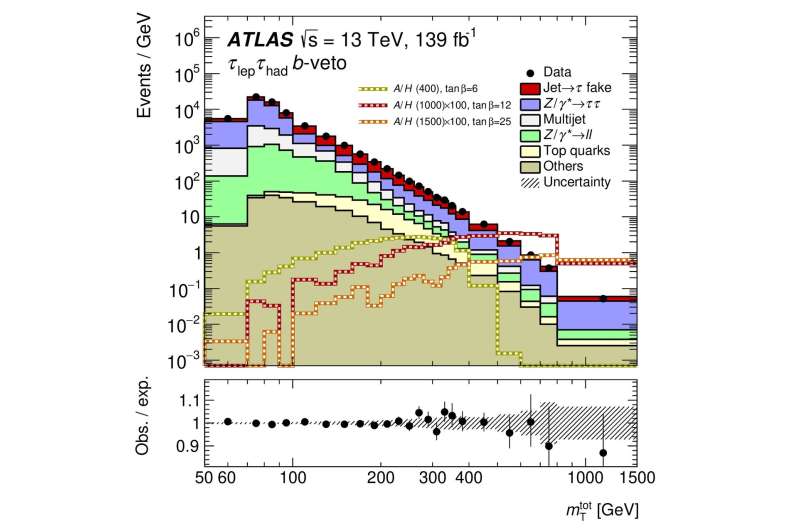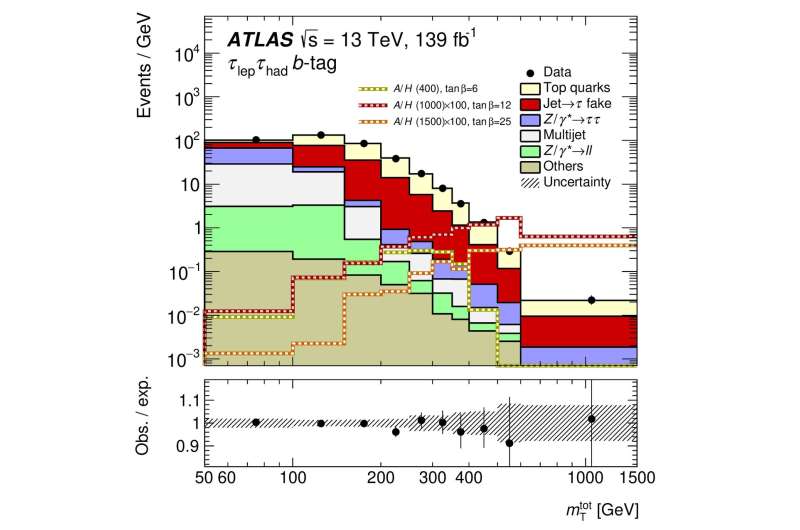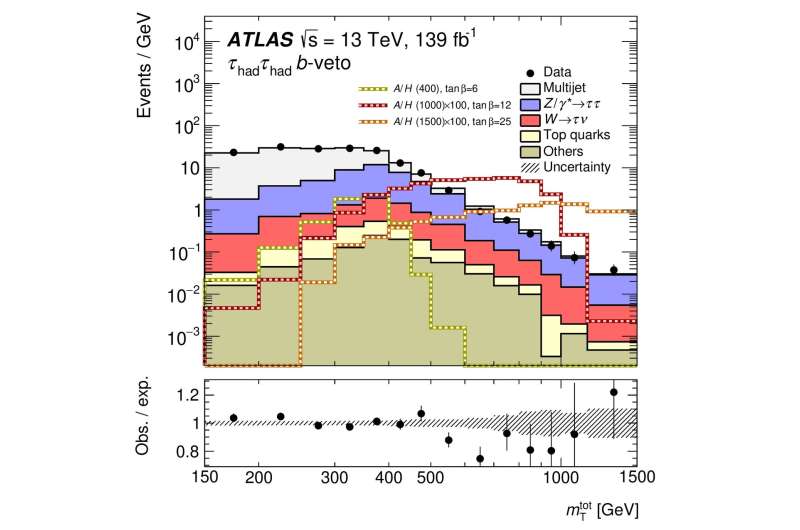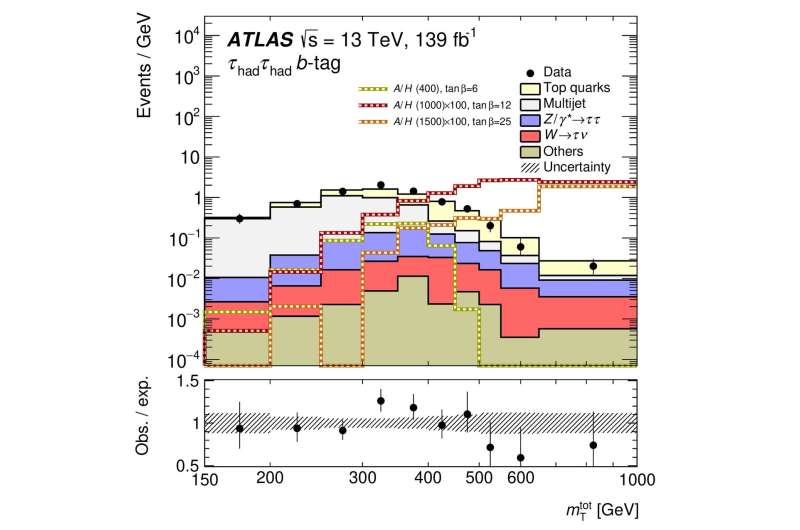The mTtot for the b-veto (left) and b-tag (right) categories of the τlepτhad channel (top) and τhadτhad channel (bottom). The binning displayed is that entering into the fit. The predictions and uncertainties for the background processes are obtained from the fit assuming the background-only hypothesis. Expectations from signal processes are superimposed. Overflows are included in the last bin of the distributions. Credit: CERN.
In particle physics, three out of the four known fundamental forces in the universe, namely electromagnetic, weak and strong interactions, are described by a theory known as the standard model (SM). One extension of this model is supersymmetry (SUSY), a theoretical construct that points to a possible relationship between two classes of particles: bosons and fermions.
SUSY theory explains a number of mathematical coincidences in the SM and is a fundamental component of string theory, one of the most promising constructs merging the SM with theories of gravity. It also predicts the existence of several new particles, none of which have been observed so far. For instance, it suggests that there are at least five types of Higgs bosons, rather than just the one type that has been observed so far.
While SUSY is theoretically appealing, there is no evidence that it applies to the real world, and if it does, the particles it predicts were presumably too heavy to be observed in previous experiments. In recent years, physicists worldwide have been trying to observe them directly in order to prove the validity of SUSY theory and understand the properties of these new particles.
The ATLAS Collaboration is a large team of researchers from multiple institutes worldwide who are working together to analyze and better understand the measurements recorded by the ATLAS detector at CERN. In a recent paper published in Physical Review Letters, the researchers presented the results of a search for heavy neutral Higgs bosons based on the analysis of data collected by the ATLAS detector.
The mTtot for the b-veto (left) and b-tag (right) categories of the τlepτhad channel (top) and τhadτhad channel (bottom). The binning displayed is that entering into the fit. The predictions and uncertainties for the background processes are obtained from the fit assuming the background-only hypothesis. Expectations from signal processes are superimposed. Overflows are included in the last bin of the distributions. Credit: CERN.
"We have carried out several searches for more Higgs bosons, but this search is sensitive to more of the 'parameter space' of the SUSY Higgses than any other," William John Murray, one of the researchers who carried out the study, told Phys.org. "This particular paper is not the first of its kind, but it uses four times as much data as previous studies (i.e., all the data we have), as well as improved methods."
The ATLAS detector was designed to measure the particles emerging from collisions in the Large Hadron Collider (LHC), which is the largest and most powerful particle accelerator in the world today. It specifically identifies electrons and two types of particles that share some similarities with electrons, namely muons and taus.
Taus are particularly difficult to measure, as they decay very quickly. When they decay, they produce an invisible neutrino and either an electron, muon, or most commonly pions (i.e., hadrons made of quarks). The ATLAS collaboration specifically searched for pairs of decaying taus, focusing on cases in which both taus produced pions or where one produced either an electron or muon and the other produced pions.
The mTtot for the b-veto (left) and b-tag (right) categories of the τlepτhad channel (top) and τhadτhad channel (bottom). The binning displayed is that entering into the fit. The predictions and uncertainties for the background processes are obtained from the fit assuming the background-only hypothesis. Expectations from signal processes are superimposed. Overflows are included in the last bin of the distributions. Credit: CERN.
"The LHC produces around a billion collisions a second, essentially all of which produce pions, so the problem that we set out to solve was to discern between pions coming from a tau decay and those that do not (referred to as 'fakes' in this context)," Murray said. "To do this, we had to measure how often we got it right—and how often we got it wrong. Controlling 'fake pions' is one of the biggest problems for the measurement."
To study pairs of taus, the researchers combined their measured momenta and estimated how heavy a given particle would have to be in order to produce that specific pair of particles while decaying. Subsequently, they built a histogram representing the mass they estimated and searched for a "bump" in the graph, as this would hint to the presence of a Higgs boson particle that was never observed before.
"There was a serious possibility of discovering a second Higgs boson and strongly hinting at supersymmetry," Murray said. "Our paper places new constraints on supersymmetric theories. Popper argues that theories must be falsifiable to be science. By eliminating parts of the supersymmetry parameter space, we reduce the possible wrong models that theorists can propose, thus bringing our field of study one step closer to the truth."
The mTtot for the b-veto (left) and b-tag (right) categories of the τlepτhad channel (top) and τhadτhad channel (bottom). The binning displayed is that entering into the fit. The predictions and uncertainties for the background processes are obtained from the fit assuming the background-only hypothesis. Expectations from signal processes are superimposed. Overflows are included in the last bin of the distributions. Credit: CERN.
While this study by the ATLAS Collaboration did not lead to the observation of novel heavy Higgs bosons, it narrowed down the parameters within which these particles could be detected and observed. In the future, it could thus inform new searches aimed at directly observing these new particles and confirming their existence.
"We are now exploring alternate 'beyond the standard model' theories that predict other signatures," Murray said. "The very large LHC dataset could allow us to have a closer look at many other signatures—any of which might turn out to contain something new. Several of these were revealed at this year's ICHEP conference—but none were successful so far."
More information: Search for Heavy Higgs bosons decaying into two Tau leptons with the ATLAS detector using pp collisions at √s=13 TeV. Physical Review Letters (2020). DOI: 10.1103/PhysRevLett.125.051801.
Journal information: Physical Review Letters
© 2020 Science X Network



























